
The Battle of Leipzig, also known as the Battle of the Nations, was fought from 16 to 19 October 1813 at Leipzig, Saxony. The Coalition armies of Austria, Prussia, Sweden, and Russia, led by Tsar Alexander I and Karl von Schwarzenberg, decisively defeated the Grande Armée of French Emperor Napoleon Bonaparte. Napoleon's army also contained Polish and Italian troops, as well as Germans from the Confederation of the Rhine. The battle was the culmination of the German Campaign of 1813 and involved 560,000 soldiers, 2,200 artillery pieces, the expenditure of 400,000 rounds of artillery ammunition, and 133,000 casualties, making it the largest battle of the Napoleonic Wars, and the largest battle in Europe prior to World War I.
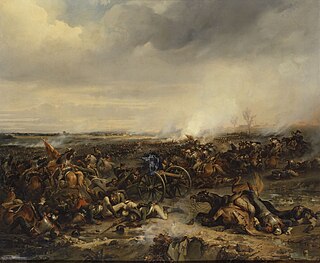
The Battle of Champaubert was the opening engagement of the Six Days' Campaign. It was fought between a French army led by Emperor Napoleon and a small Russian corps commanded by Lieutenant General Count Zakhar Dmitrievich Olsufiev. After putting up a good fight, the Russian formation was destroyed; the survivors escaped into the woods while Olsufiev became a French prisoner. Champaubert is located in France, 46 kilometres (29 mi) west of Châlons-en-Champagne and 69 kilometres (43 mi) east of Meaux.

The Battle of Craonne was a battle between an Imperial French army under Emperor Napoleon I opposing a combined army of Imperial Russians and Prussians led by Prussian Field Marshal Gebhard Leberecht von Blücher. The War of the Sixth Coalition engagement began when the bulk of Napoleon's army tried to drive Mikhail Semyonovich Vorontsov's 22,000 Russians off the Chemin des Dames plateau to the west of Craonne. After a bitter struggle, Napoleon's attacks compelled Vorontsov's force to withdraw, but French casualties exceeded Russian losses. While the battle raged, Blücher's attempt to turn Napoleon's east flank ended in failure due to poor planning.

The Battle of Montmirail was fought between a French force led by Emperor Napoleon and two Allied corps commanded by Fabian Wilhelm von Osten-Sacken and Ludwig Yorck von Wartenburg. In hard fighting that lasted until evening, French troops including the Imperial Guard defeated Sacken's Russian soldiers and compelled them to retreat to the north. Part of Yorck's Prussian I Corps tried to intervene in the struggle but it was also driven off. The battle occurred near Montmirail, France, during the Six Days Campaign of the Napoleonic Wars. Montmirail is located 51 kilometres (32 mi) east of Meaux.

The Battle of Rossbach took place on 5 November 1757 during the Third Silesian War near the village of Rossbach (Roßbach), in the Electorate of Saxony. It is sometimes called the Battle of, or at, Reichardtswerben, after a different nearby town. In this 90-minute battle, Frederick the Great, king of Prussia, defeated an Allied army composed of French forces augmented by a contingent of the Reichsarmee of the Holy Roman Empire. The French and Imperial army included 41,110 men, opposing a considerably smaller Prussian force of 22,000. Despite overwhelming odds, Frederick managed to defeat the Imperials and the French.
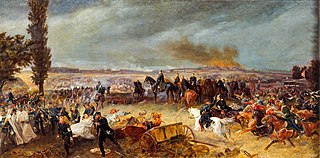
The Battle of Königgrätz was the decisive battle of the Austro-Prussian War in which the Kingdom of Prussia defeated the Austrian Empire. It took place on 3 July 1866, near the Bohemian city of Hradec Králové and village of Sadová, now in the Czech Republic.

Friedrich Wilhelm Freiherr von Seydlitz was a Prussian officer, lieutenant general, and among the greatest of the Prussian cavalry generals. He commanded one of the first Hussar squadrons of Frederick the Great's army and is credited with the development of the Prussian cavalry to its efficient level of performance in the Seven Years' War. His cavalryman father retired and then died while Seydlitz was still young. Subsequently, he was mentored by Margrave Frederick William of Brandenburg-Schwedt. Seydlitz's superb horsemanship and his recklessness combined to make him a stand-out subaltern, and he emerged as a redoubtable Rittmeister in the War of Austrian Succession (1740–1748) during the First and Second Silesian wars.

The Battle of Lobositz or Lovosice also Lowositz on 1 October 1756 was the opening land battle of the Third Silesian War and the wider Seven Years' War. Frederick the Great's 28,000 Prussians were prevented by 33,000 Austrians under Maximilian Ulysses Count von Browne from continuing their invasion into the rich Bohemian plain, forcing Frederick to ultimately fall back north into Saxony for the winter.
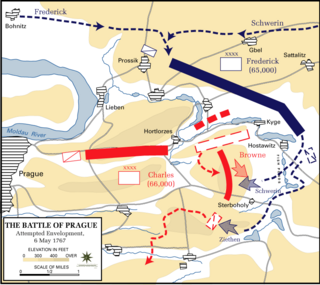
In the Battle of Prague or Battle of Štěrboholy, fought on 6 May 1757 during the Third Silesian War, Frederick the Great's 64,000 Prussians forced 60,000 Austrians to retreat, but having lost 14,300 men, decided he was not strong enough to attack Prague. The battle is mentioned in the famous German ballad Lenore written in 1773 by Gottfried August Bürger.

The Battle of Kolín (Kolin) on 18 June 1757 saw 54,000 Austrians under Count von Daun defeat 34,000 Prussians under Frederick the Great during the Third Silesian War. Prussian attempts to turn the Austrian right flank turned into piecemeal frontal attacks and were defeated in five and a half hours of combat. The Prussians lost 13,733 men, the Austrians 8,100. Frederick gave up the siege of Prague as well as his planned march on Vienna and retreated to Saxony.
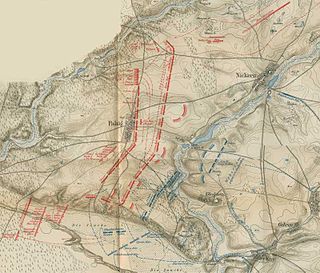
The Battle of Kay, also referred to as the Battle of Sulechów, Battle of Züllichau, or Battle of Paltzig, was an engagement fought on 23 July 1759 during the Seven Years' War. It occurred near Kay (Kije) in the Neumark, now part of Poland.

The Battle of Kunersdorf occurred on 12 August 1759 near Kunersdorf immediately east of Frankfurt an der Oder. Part of the Third Silesian War and the wider Seven Years' War, the battle involved over 100,000 men. An Allied army commanded by Pyotr Saltykov and Ernst Gideon von Laudon that included 41,000 Russians and 18,500 Austrians defeated Frederick the Great's army of 50,900 Prussians.
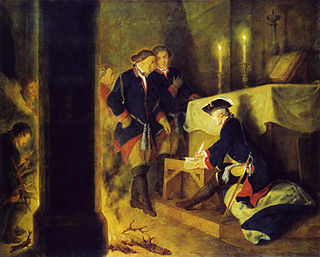
In the Battle of Torgau on 3 November 1760, King Frederick the Great's Prussian army fought an Austrian army under the command of Field Marshal Leopold Josef Graf Daun. The Prussians won a costly victory in one of the bloodiest battles of the Third Silesian War.

The Battle of Kulm was fought near the town Kulm and the village Přestanov in northern Bohemia. It was fought on 29–30 August 1813, during the War of the Sixth Coalition. A French corps under General Dominique Vandamme attacked Alexander Osterman-Tolstoy's Russian corps on 29 August. The next day, Friedrich von Kleist's Prussian corps hit Vandamme in the rear while Russian and Austrian reinforcements attacked the French front and left. Vandamme was defeated with the loss of between 13,000 and 25,000 men and 82 guns.

The Battle of Heilsberg took place on 10 June 1807, during the Napoleonic Wars.

The Battle of Château-Thierry saw the Imperial French army commanded by Emperor Napoleon attempt to destroy a Prussian corps led by Ludwig Yorck von Wartenburg and an Imperial Russian corps under Fabian Wilhelm von Osten-Sacken. The two Allied corps managed to escape across the Marne River, but suffered considerably heavier losses than the pursuing French. This action occurred during the Six Days' Campaign, a series of victories that Napoleon won over Prussian Field Marshal Gebhard Leberecht von Blücher's Army of Silesia. Château-Thierry lies about 75 kilometres (47 mi) northeast of Paris.

The Battle of Fère-Champenoise was fought between two Imperial French corps led by Marshals Auguste de Marmont and Édouard Mortier, duc de Trévise and a larger Coalition force composed of cavalry from the Austrian Empire, Kingdom of Prussia, Kingdom of Württemberg, and Russian Empire. Caught by surprise by Field Marshal Karl Philipp, Prince of Schwarzenberg's main Coalition army, the forces under Marmont and Mortier were steadily driven back and finally completely routed by aggressive Allied horsemen and gunners, suffering heavy casualties and the loss of most of their artillery. Two divisions of French National Guards under Michel-Marie Pacthod escorting a nearby convoy were also attacked and wiped out in the Battle of Bannes. The battleground was near the town Fère-Champenoise located 40 kilometres (25 mi) southwest of Châlons-en-Champagne.
Karl Daniel Gottfried Wilhelm von Stutterheim, born 6 August 1770 – died 13 December 1811, served in the Prussian and Saxon armies during the French Revolutionary Wars, leaving the latter service in 1798. He spent most of his career in the army of Habsburg Austria and the Austrian Empire. He commanded a brigade in combat against the First French Empire during the 1805 and 1809 wars. In the latter conflict, he led his troops with dash and competence. He authored two histories about the wars; the second work remained unfinished due to his suicide in 1811.

The Battle of Gué-à-Tresmes was fought between 14,500 French troops led by Marshals Auguste de Marmont and Édouard Mortier and 12,000 Prussians commanded by Friedrich Graf Kleist von Nollendorf and Friedrich von Katzler. On 28 February the French attacked and drove the Prussians to the north along the west bank of the river Ourcq. That evening and the next day Kleist tried to push the French back while Russian units under Peter Mikhailovich Kaptzevich tried to cross from the east to the west bank of the Ourcq; the Allies were unsuccessful. Gué-à-Tresmes is located where Route D405 crosses the Thérouanne stream about 10 kilometres (6.2 mi) northeast of Meaux.

The Battle of Laubressel saw the main Allied army of Field Marshal Karl Philipp, Prince of Schwarzenberg mount a three-pronged converging attack on the weaker army of Marshal Jacques MacDonald. The French forces under Marshal Nicolas Oudinot bore the brunt of the fighting, in which the Allies tried to turn their left flank. The French abandoned Troyes and retreated west as a result of the action. The village of Laubressel is located 10 kilometres (6 mi) east of Troyes.



















